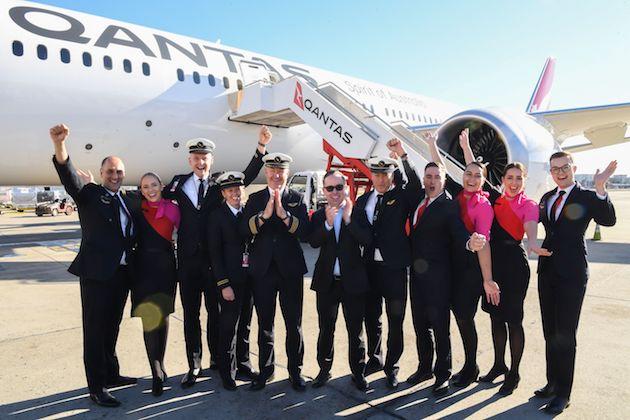Move FM Australian News

In world first, Qantas flies direct from New York City to Sydney
Oct 21, 2019SYDNEY, Australia – Qantas Flight 7879 touched down at Sydney airport on Sunday morning, ending the longest commercial flight undertaken in aviation history.
Departing from New York’s John F. Kennedy Airport on Saturday, the plane took 19 hours and sixteen minutes to complete its journey.
The purpose of the flight was to run a series of experiments to assess health and well-being onboard. Data from these experiments will be used to help shape the crew rostering and customer service of the airlines’ ultra long haul flights in future including Project Sunrise.
The Boeing 787-9 was flown from Seattle earlier on Saturday by Captain Lisa Norman, a 30-year veteran of the airline who piloted last year’s first direct flight from Perth to London. The flight to Sydney from New York however was under Captain Sean Golding, another three-decade veteran.
With 49 passengers and crew on board, the aircraft departed Kennedy at 9:00pm.
Tests ranged from monitoring pilot brain waves, melatonin levels and alertness, through to exercise classes for passengers.
Cabin lighting and in-flight meals were also adjusted in ways that are expected to help reduce jetlag, according to the medical researchers and scientists.
Arriving in Sydney, Qantas Group CEO Alan Joyce said: “This is a really significant first for aviation. Hopefully, it’s a preview of a regular service that will speed up how people travel from one side of the globe to the other.”
“We know ultra long-haul flights pose some extra challenges but that’s been true every time technology has allowed us to fly further. The research we’re doing should give us better strategies for improving comfort and wellbeing along the way.
“Night flights usually start with dinner and then lights off. For this flight, we started with lunch and kept the lights on for the first six hours, to match the time of day at our destination. It means you start reducing the jetlag straight away.
“What’s already clear is how much time you can save. Our regular, one-stop New York to Sydney service (QF12) took off three hours before our direct flight but we arrived a few minutes ahead of it, meaning we saved a significant amount of total travel time by not having to stop,” added Joyce.
Qantas Captain Sean Golding, who led the four pilots operating the service, said: “The flight went really smoothly. Headwinds picked up overnight, which slowed us down to start with, but that was part of our scenario planning. Given how long we were airborne, we were able to keep optimising the flight path to make the best of the conditions.”
“We had a lot of interest from air traffic controllers as we crossed through different airspace because of the uniqueness of this flight. We also had a special sign off and welcome home from the control towers in New York and Sydney, which you don’t get every day.”
“Overall, we’re really happy with how the flight went and it’s great have some of the data we need to help assess turning this into a regular service,” said Captain Golding.
Two more research flights are planned as part of the Project Sunrise evaluations London to Sydney in November and another New York to Sydney in December. Emissions from all research flights will be fully offset, the airline said.
A decision on Project Sunrise is expected by the end of the year.
Qantas named its endeavor “Project Sunrise” after the airline’s historic ‘Double Sunrise’ endurance flights during the Second World War, which remained airborne long enough to see two sunrises.
Fast Facts
QF 7879 non-stop flight from New York to Sydney took 19 hours and 16 minutes. Distance between New York and Sydney is 16,200 kilometres. This compares to a travel time of 22 hours and 20 minutes on the current New York to Sydney via Los Angeles flight.
The flight was operated by a brand new Boeing 787-9, registration VH ZNI, named “Kookaburra”
Months of flight planning has gone in to determining the optimum flight path, including running daily plans to establish wind and weather patterns
Four pilots were on rotation throughout the flight. Two additional pilots were be in the cabin, having flown the aircraft to New York. Total flight experience on the aircraft was 67,000 hours.
The aircraft operated with a maximum fuel load of approx. 101,000kg. Projected fuel remaining upon landing was approximately 6,000kg which translates to about 90 minutes of flight time.
Maximum take-off weight for a 787-9 is 254,000kg. QF 7879 JFK to SYD departed at 233,000kg take-off weight with the same amount of fuel 101,000kg that Qantas departs Perth to London flights with.
Nearly half of the aircraft weight on take-off was fuel. The other were aircraft, passengers and bags.
Flight was at 85% of the the speed of sound which is around 930 kilometres an hour. Cruising altitude started at 36,000 feet for the first few hours and then as the aircraft weight reduced with fuel burn, the cruising altitude increased to 40,000 feet.
Pantry galley weight was 1,500kg’s (food, trolleys etc.)
“Findings on crew wellbeing will be shared with the Australian Civil Aviation Safety Authority to help inform regulatory requirements associated with ultra-long-haul flights over 20 hours,” Qantas said in it’s statement.
(Photo credit: James D. Morgan | Qantas).


